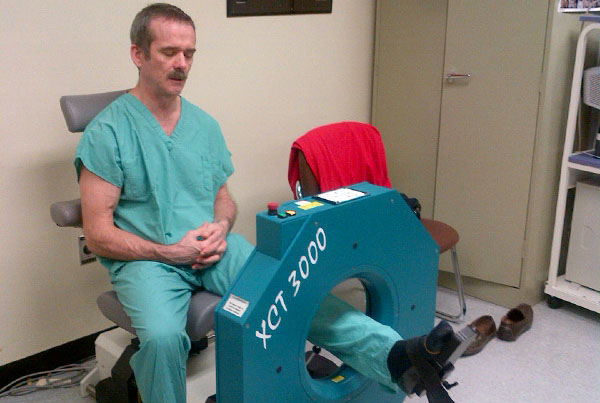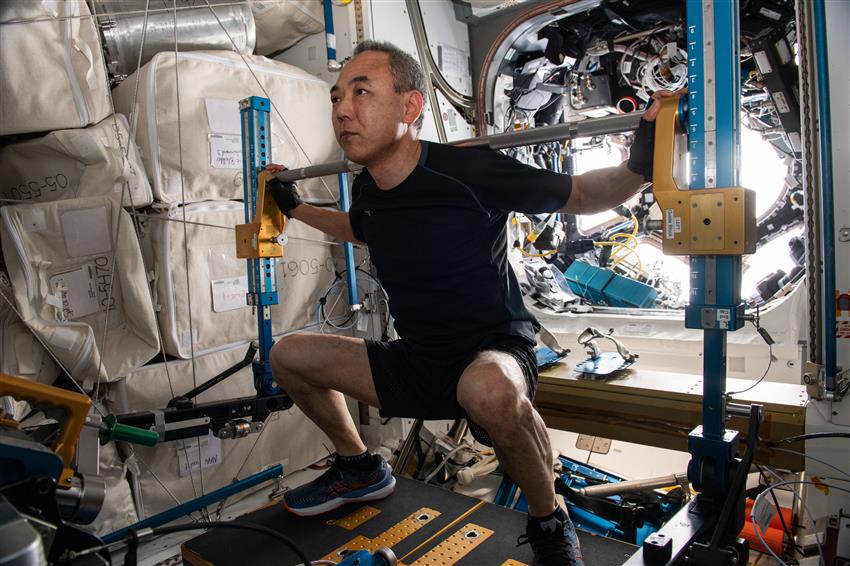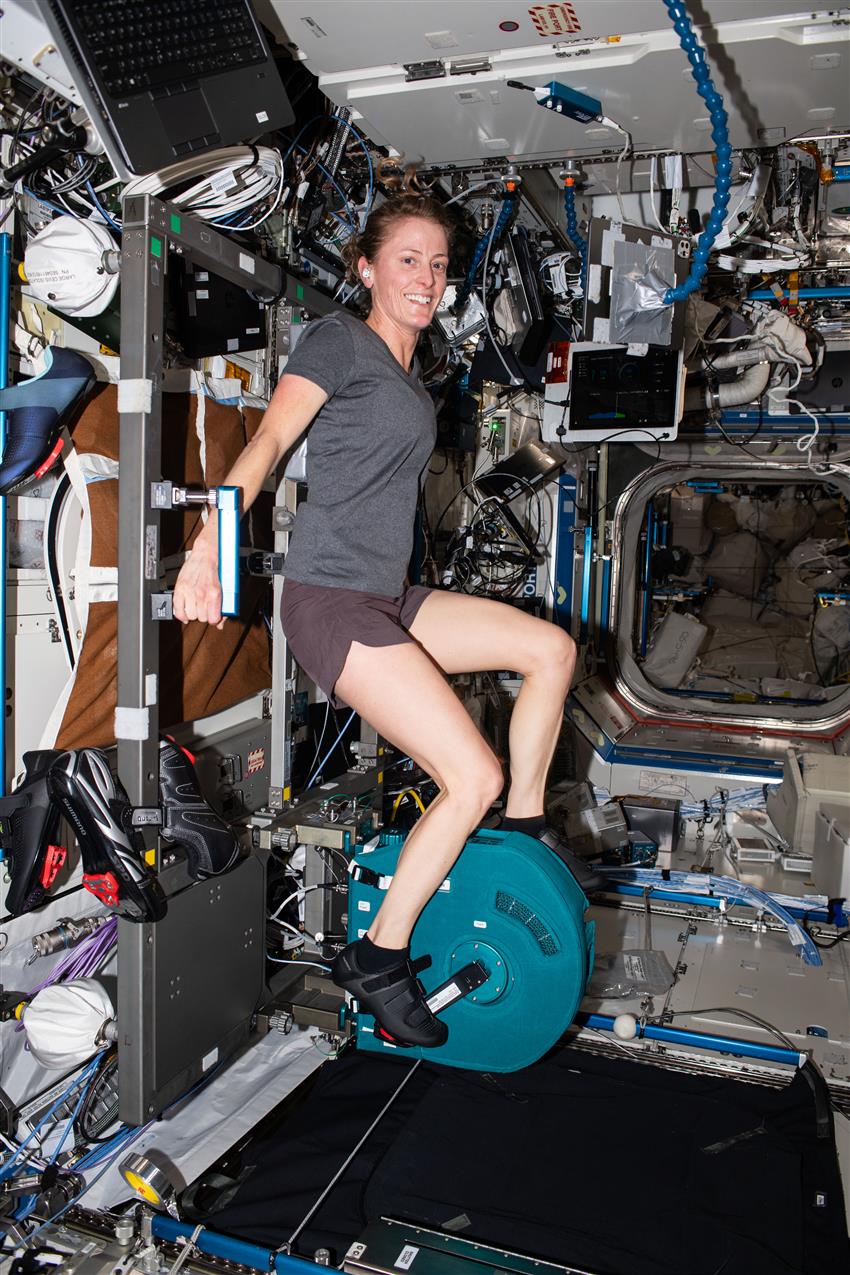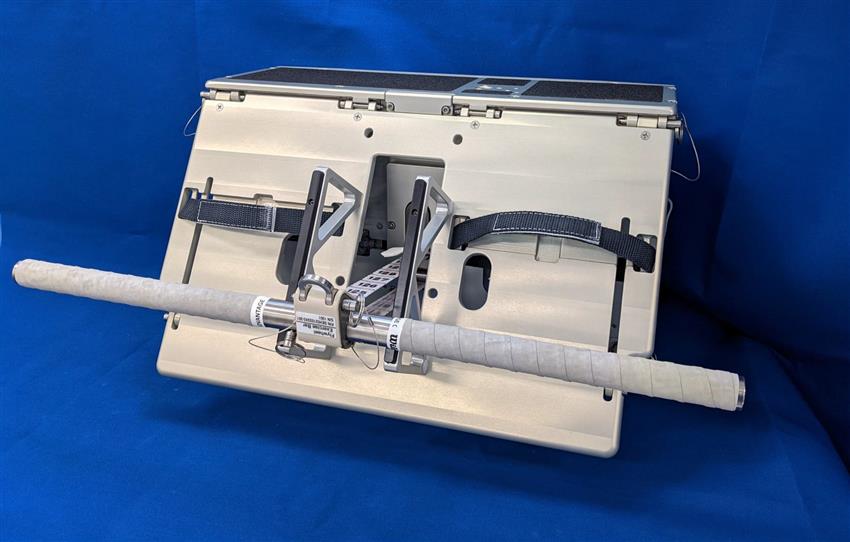Physical activity in space
Everyone knows that it's important to exercise to stay in shape—on Earth, that is. But when you're in orbit, exercise is absolutely vital!
Physical activity is the most effective way to counteract the adverse effects of weightlessness on the human body. Exercise is therefore a crucial part of the daily routine of astronauts, both on Earth and in space.
On this page
The importance of physical activity in orbit
On Earth, each time we move, gravity provides resistance to the muscles and bones of our body. It's like we're exercising without even realizing it! That way, our body stays strong enough to support our weight.
In microgravity, however, bones and muscles no longer have to support the weight of astronauts' bodies. What's more, the cardiovascular system becomes lazy because the heart doesn't have to work as hard as it does on Earth to counteract gravity and pump blood around the body up to the head.
"Astronauts' bones become more fragile after time spent in space."
If astronauts didn't exercise while they were in space, their bodies would experience major loss in:
In other words, astronauts need to exercise in order to:
- mitigate the deterioration of their bones
- maintain the strength of their muscles and their heart
- remain strong enough to do spacewalks
- be able to carry out emergency procedures during landing
- stay healthy and in shape until they return to Earth and to gravity
The longer astronauts spend in space, the more significant the effects are on their body. Astronauts who live and work for several months at a time aboard the ISS are especially affected.
In the future, astronauts will travel to the Moon aboard the Orion spacecraft and eventually spend time on the Lunar Gateway. While the trip to the Moon will only take a few days, they will spend up to three months inside the Gateway. New innovative exercise equipment will be required.
Side effects of weightlessness on the human body
Flying in space is a bit like aging prematurely.

Chris Hadfield undergoes a quantitative CT scan to obtain detailed images of the bones in his ankle, shortly after his return to Earth in 2013. (Credit: Canadian Space Agency [CSA])
Despite a rigorous exercise regime, astronauts lose an average of 1% of their bone density per month in space. On Earth, an average elderly person loses 1% of his or her bone density per year.
The physical consequences of a prolonged journey in weightlessness are similar to those caused by osteoporosis, which affects elderly people. However, these consequences aren't as serious because astronauts' bone density gradually returns to normal after they return to Earth.
That is why scientists use astronauts as participants in their scientific experiments. This research allows us to gain a better understanding of the effects of weightlessness and how to mitigate them, for the purposes of current and future long-duration space missions, but also for people with various health problems on Earth.
Thanks to the current protocol of two hours of exercise per day on the ISS, some astronauts return to Earth with more muscle mass than when they blasted off. But results vary!
ISS gym
In this section
CSA astronaut David Saint-Jacques talks about working out on the ISS and explains the unique exercise equipment he uses in space: the stationary bicycle, the treadmill and the Advanced Resistive Exercise Device (ARED). (Credits: CSA, NASA)
TranscriptOver the course of a long-duration mission, astronauts must exercise approximately two hours per day! And exercising looks a bit different in microgravity. Exercise machines aboard the ISS have been modified to simulate a gravitational pull being exerted on the astronauts' bodies.
The crewmembers on the ISS use three cardiovascular and muscular exercise machines to stay in shape.
ARED: Advanced Resistive Exercise Device
Robert Thirsk - ARED
- Type of exercise: Maintains muscle strength and bone density by targeting the major muscle groups.
- Special features: This device uses vacuum cylinders. They exert up to 272 kilograms of resistance on a bar or cable. The device imitates free weights used on Earth.
- Method of use:
- Adjust the resistance to the desired level.
- Adjust the bar or cable for the chosen exercise.
- Perform heel lifts, squats and deadlifts, depending on the muscles to be worked as prescribed by the exercise specialist.
Treadmill
Robert Thirsk - TVIS
- Type of exercise: Cardiovascular, muscular and skeletal.
- Special features: A harness connected to a treadmill apply a load to the shoulders and hips based on the astronaut's body weight. At the start of a mission, the load is set at 60% of the astronaut's body weight. The load is increased throughout the mission until it is at 85% of body weight.
- Method of use:
- Put on the harness system.
- Adjust the load of the harness based on the desired intensity of the workout.
- Run!
During his six-month mission on the ISS, Robert Thirsk ran "alongside" his son!
He used videos filmed by the CSA that showed his son running. Robert watched the videos on the treadmill's screen, and the illusion was complete!
Stationary bike
- Type of exercise: Cardiovascular.
- Method of use :
- Put on cycling shoes and place feet on the clip pedals.
- Grasp the hand holds to maintain position on the machine. No seat required!
- Pedal!
Exercising in a tiny capsule
Inside the Orion spacecraft, Artemis astronauts will do a 30-minute workout nearly every day as they travel to the Moon.
On Artemis II, the first crewed flight of the Artemis program, the four astronauts will test an innovative new piece of equipment during their 10-day mission.
The flywheel, a versatile small piece of equipment, is essential for these workouts. It is placed under the door of the spaceship and doubles as a step for the crew to get in and out. This flywheel works kind of like a yo-yo; the faster the movement is performed, the harder it gets. It also has three levels of resistance to make exercises harder or easier. It can be used for aerobic (rowing) and resistance training (squats, deadlifts, bent-over row) and generate up to 180 kilograms of resistance.
Orion's exercise gear is super lightweight, only 14 kilograms, and it's smaller than a regular carry-on suitcase. In comparison, the equipment on the ISS weighs over 1800 kilograms and takes up a lot of space, nearly 80 square metres. This is a great example of exercise technology innovation!
As we prepare to build the Lunar Gateway to return astronauts to the surface of the Moon and, eventually, to Mars, can you think of future innovative exercise equipment?


